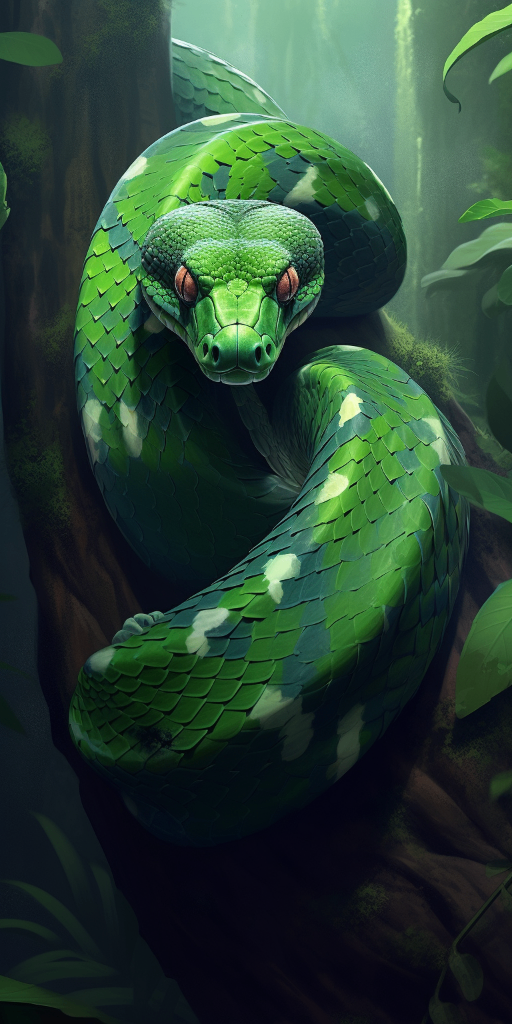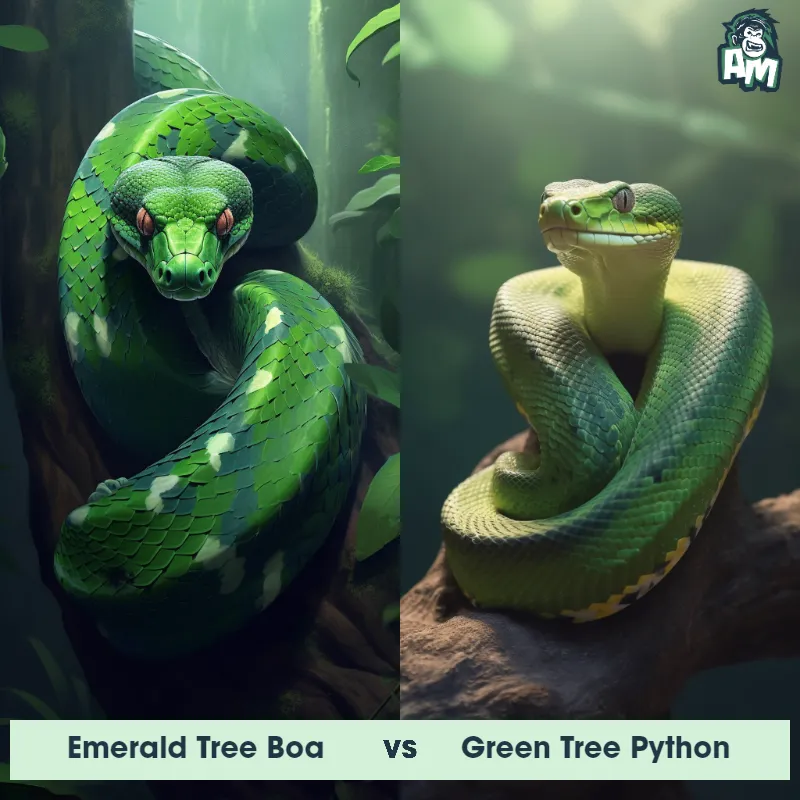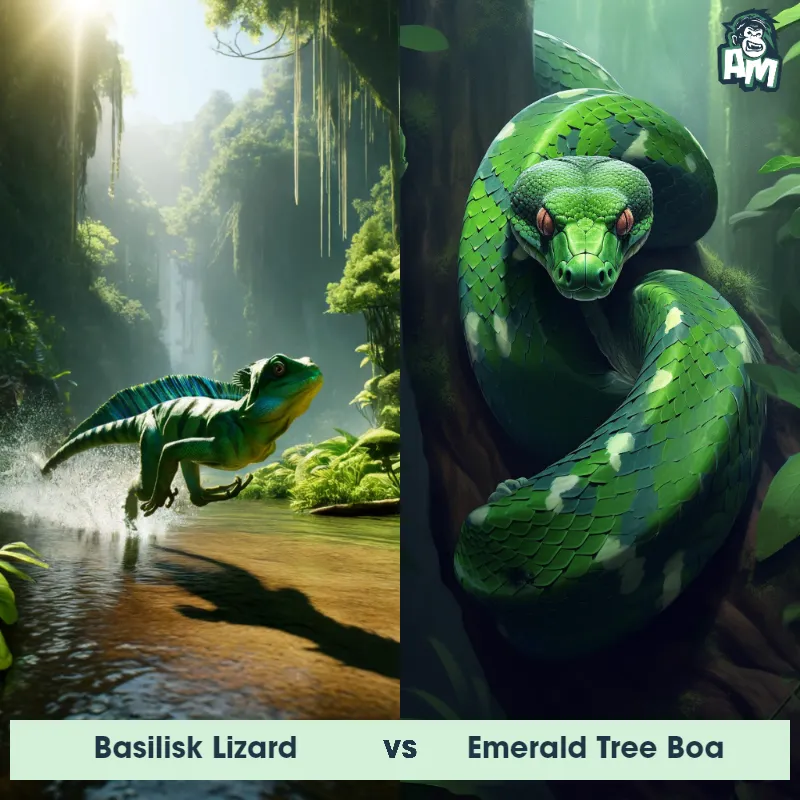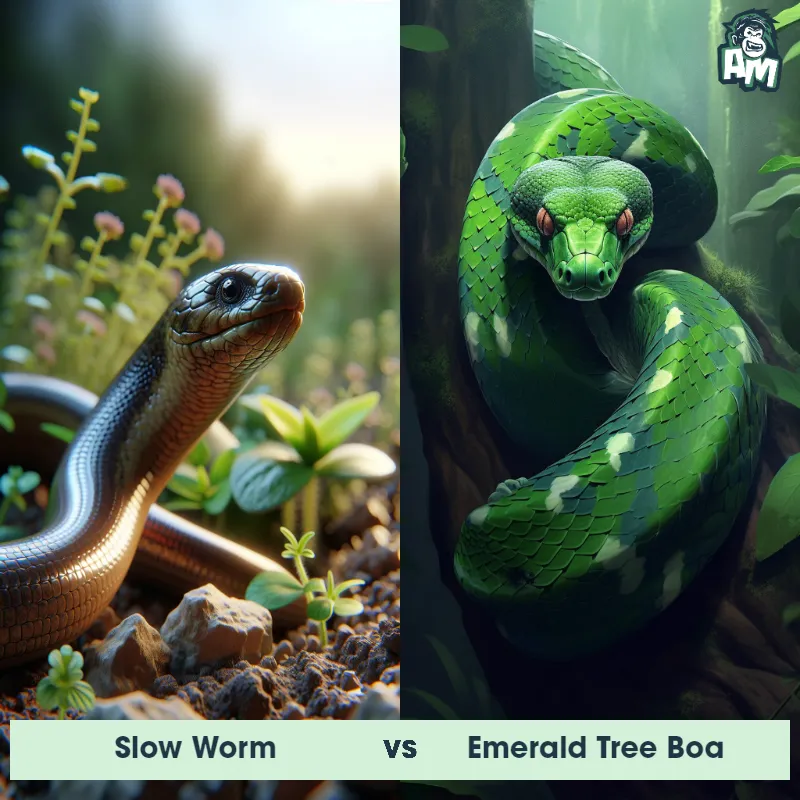The Emerald Tree Boa
The Emerald Tree Boa, scientifically known as Corallus caninus, is a non-venomous snake species found in the rainforests of South America. It is known for its vibrant green coloration, which helps it blend seamlessly into the lush vegetation. This species has a robust body and can grow up to 6 feet in length, with males being smaller than females. Its most distinctive feature is its prehensile tail, which acts as a fifth limb, allowing it to hang from tree branches for extended periods. The Emerald Tree Boa has large, forward-facing eyes, that are a striking yellow color, and it possesses sharp, recurved teeth for capturing and holding onto its prey.

| Emerald Tree Boa | |
|---|---|
| Size | 6-7 feet (1.8-2.1 meters) |
| Weight | 7-10 pounds (3-4.5 kilograms) |
| Speed | NA |
| Key Strength | Constricting ability |
| Biggest Weakness | Vulnerable to attacks from above |
| Scientific Name | Corallus caninus |
| Family | Boidae |
| Habitat | Rainforests |
| Geography | South America |
| Diet | Small mammals, birds, and lizards |
| Lifespan | 12 years - 20 years |

The Emerald Tree Boa
The Emerald Tree Boa, scientifically known as Corallus caninus, is a non-venomous snake species found in the rainforests of South America. It is known for its vibrant green coloration, which helps it blend seamlessly into the lush vegetation. This species has a robust body and can grow up to 6 feet in length, with males being smaller than females. Its most distinctive feature is its prehensile tail, which acts as a fifth limb, allowing it to hang from tree branches for extended periods. The Emerald Tree Boa has large, forward-facing eyes, that are a striking yellow color, and it possesses sharp, recurved teeth for capturing and holding onto its prey.
Fun Fact: The Emerald Tree Boa is known for its characteristic S-shaped striking posture, which it adopts when threatened or defending its territory. It will curl its body into the shape of an S, raising its head, neck, and anterior section of its body off the ground, showcasing the beautiful dorsal pattern that resembles a series of diamonds, thus intimidating its predators or intruders.
| Emerald Tree Boa | |
|---|---|
| Size | 6-7 feet (1.8-2.1 meters) |
| Weight | 7-10 pounds (3-4.5 kilograms) |
| Speed | NA |
| Key Strength | Constricting ability |
| Biggest Weakness | Vulnerable to attacks from above |
| Scientific Name | Corallus caninus |
| Family | Boidae |
| Habitat | Rainforests |
| Geography | South America |
| Diet | Small mammals, birds, and lizards |
| Lifespan | 12 years - 20 years |
Emerald Tree Boa Matchups
We use AI to simulate matchups between the Emerald Tree Boa and other animals. Our simulation considers size, strength, and natural predatory behaviors to determine the most likely outcome.
Emerald Tree Boa: Diet, Predators, Aggression, and Defensive Behaviors
What do Emerald Tree Boas eat?
Emerald Tree Boas primarily feed on small mammals, birds, and occasionally reptiles. Their diet consists mainly of rodents such as mice, rats, and squirrels. They are ambush predators and rely on their excellent camouflage and stealth to catch their prey.
Do Emerald Tree Boas have any predators?
While adult Emerald Tree Boas do not have many predators due to their large size and impressive defensive abilities, they are vulnerable to large birds of prey and certain mammals such as ocelots and jaguars. However, their biggest threat comes from human activities such as deforestation and illegal pet trade.
Are Emerald Tree Boas aggressive?
Emerald Tree Boas are generally not considered aggressive towards humans unless they feel threatened or provoked. They may strike or bite if they perceive a threat, but they are relatively calm and docile in their natural habitat. Proper handling and care can help minimize any aggression towards humans.
Do Emerald Tree Boas fight with other snakes?
Emerald Tree Boas are solitary creatures and do not engage in fights with other snakes of their species unless it is during mating season or territorial disputes. They use their bodies to push against each other to establish dominance without causing serious harm.
How do Emerald Tree Boas defend themselves?
When threatened, Emerald Tree Boas rely on their impressive defensive tactics to protect themselves. They may strike, bite, or coil their bodies tightly around the predator or threat to deter them. Their cryptic coloration also helps them blend into their surroundings, making them less visible to potential threats.
What is the biggest weakness of Emerald Tree Boas in a fight?
Despite their strong defensive abilities, the biggest weakness of Emerald Tree Boas in a fight is their relatively slow movement compared to agile predators. They rely on stealth and ambush tactics rather than speed to catch their prey or defend themselves, which can be a disadvantage in a fast-paced confrontation.
Fun Fact: The Emerald Tree Boa possesses specialized heat-sensing pits on its lower lip, known as labial pits, which enable it to detect warm-blooded prey even in complete darkness. These pits detect infrared radiation, allowing the snake to accurately locate its next meal, which primarily consists of birds, bats, and small mammals.
Fun Fact: Unlike most other snake species, the Emerald Tree Boa is viviparous, meaning it gives birth to live young instead of laying eggs. The females of this species can give birth to a litter of around 6-12 neonates, each measuring around 20 inches in length. The neonates are independent from birth and are fully capable of hunting and climbing.
















